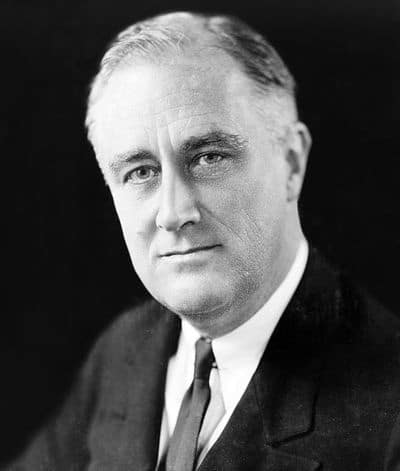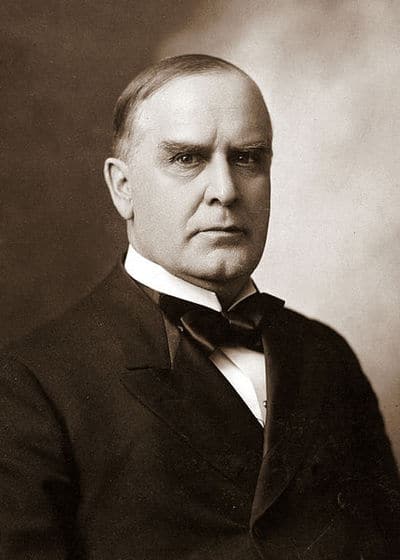Table of Contents
ToggleWhen was Franklin D. Roosevelt born?
Franklin D. Roosevelt was born in 1882.
Where was Franklin D. Roosevelt born?
Franklin D. Roosevelt was born in Hyde Park, New York.
How old was Franklin D. Roosevelt when he became president?
Franklin D. Roosevelt was elected at the age of 51.
What years was Franklin D. Roosevelt president?
Franklin D. Roosevelt was president from 1933 – 1945.
When did Franklin D. Roosevelt die?
Franklin D. Roosevelt died at the age of 63 in 1945.
How did Franklin D. Roosevelt die?
He died of a haemorrhagic stroke.
The presidency of Franklin D. Roosevelt is a fascinating one for anyone studying American Politics and history.
You have an anomaly in his ability to take office for more than two terms.
This led to a long stay in the White House that saw him handle foreign and domestic affairs from the depression through to America’s involvement in World War II, right until his death in 1945.
He would enjoy landslide victories for decades and help secure influential policies that continue to affect the lives of United States citizens to this day.
Franklin D. Roosevelt’s Political Life Prior to the Presidency
FDR’s political life began in New York in 1910 when he took over as a New York state senator. After reelection in 1912, he served as chairman for the Agriculture Committee, working on farm and labor bills alongside his other work on social welfare.
Much of this experience would be put to good use during his presidency. After a stint as the Assistant Secretary of the Navy, Roosevelt was nominated as a vice-presidential candidate alongside James M. Cox in 1920.
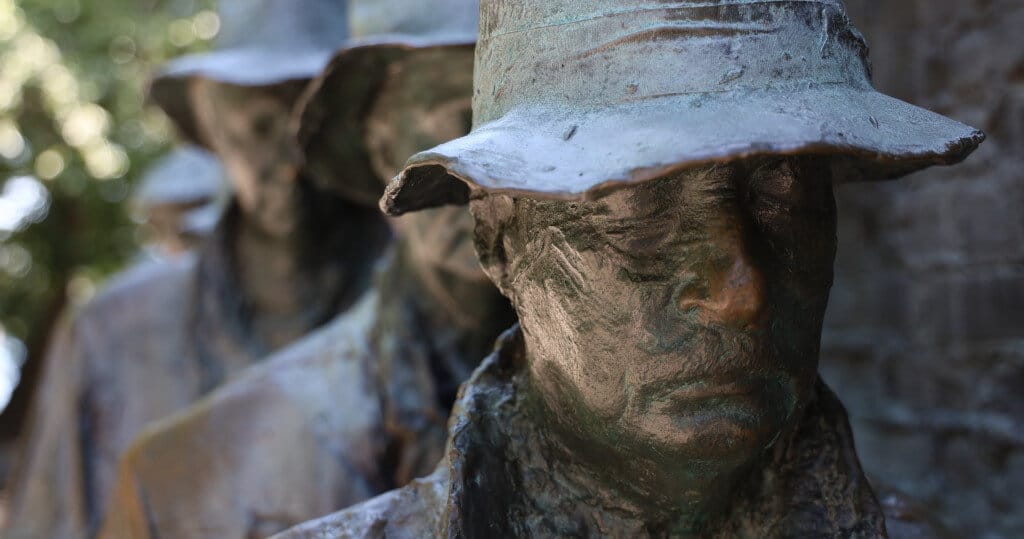
In 1929, Roosevelt would return to politics following illness, running for Governor of New York. During his time in power, he worked hard for struggling farmers and advocated the construction of hydroelectric plants.
It was during this year that the Great Depression took root following the Wall Street Crash. Roosevelt’s position and subsequent work would play a big part in his political success moving forward and his nomination for the presidency.
FDR’s 1st Term and Rebuilding With the New Deal
Franklin D. Roosevelt was victorious with a sizeable margin in his first election. All but six states voted for the Democrats and he also achieved 57% of the popular vote.
This meant a change in administration where the party could focus on rebuilding. Roosevelt offered hope to the American people and portrayed himself as a strong, dependable leader during his inauguration.

The line “the only thing we have to fear is fear itself” is often quoted as coming from Roosevelt.
One of the biggest achievements of the term was the New Deal. The New Deal focused on the “Three Rs”.
That meant relief for the unemployed struggling to survive following the economic crash, a strong recovery for the economy through careful spending and job creation, and a reform of social welfare measures.
At the same time, he would pass the Emergency Banking Act and declare a four-day national bank holiday.
Part of this social welfare reform was the creation of Social Security. This was a long process of negotiations and adapting ideas.
Initially, Roosevelt wanted a plan that combined an old-age pension, an unemployment insurance scheme, and a national health care program.

Get Smarter on US News, History, and the Constitution
Join the thousands of fellow patriots who rely on our 5-minute newsletter to stay informed on the key events and trends that shaped our nation's past and continue to shape its present.
The first two went on to be developed, helping citizens to gain state-administered aid and to contribute to a pension scheme. The national health care program did not survive.
The Fireside Chats
An important part of the legacy of the FDR presidency is the Fireside Chat. The concept was simple. He would make an address directly to the nation where the president could talk about policies and the current state of affairs in the White House.

It was a way of bringing the president closer to the people and allowing them to hear from the man, rather than the leader of a party.
The name Fireside Chat was a clever way of creating that informal feel and putting people at ease. The idea actually originated from Roosevelt’s time as New York Governor.
FDR’s 2nd Term and Further Growth and Hope for the Nation
In 1936, Roosevelt would win for a second time. His successful handling of the economy and the way he was steering the nation led many citizens to continue to stand behind him.
In fact, this second election saw him achieve an even bigger majority than the first. Only Maine and Vermont voted Republican and he increased his share of the popular vote to 60.8%.
This was an opportunity for the administration to continue its work in improving the economy and the fortunes of the American public.
Government spending would increase, which was bad news for the national debt. However, unemployment also continued to fall. There was an average increase in jobs of 5.3% annually.
A major development in this continued growth was the generation of jobs in the environment and conservation sectors. The promotion and upkeep of the national parks and forests led to the creation of the Civilian Conservation Corps.
3.4 million workers worked on planting trees, upgrading roads, and maintaining a series of state parks. 15.5 million visitors would come to these parks in 1939.
FDR’s 3rd Term and the Impact of World War II
Franklin D. Roosevelt would then go on to win a historic 3rd term in 1940. At this point in his career, the focus switched from domestic policy to foreign as the United States became more involved in World War II.

A year after his victory, Pearl Harbor was attacked by Japanese forces. Roosevelt would go on to give his “Infamy Speech” denouncing the attack and Congress would subsequently declare war on Japan.
On December 11th, Hitler and Mussolini responded with their own declaration and the United States joined the Allied forces.
Roosevelt’s response to the war
There are two important aspects to Roosevelt’s response to the war, both of which divided opinion.
The first was the endorsement and funding of the Manhattan Project. This led to the development of nuclear weapons as a means of establishing power and deterring others from future attacks.
The use of nuclear weaponry is largely attributed to Harry Truman, as he was the one to succeed Roosevelt and give the go-ahead for the bombing of Hiroshima and Nagasaki. But, the initial project began with Roosevelt.
The second is Roosevelt’s role in the creation of the United Nations. Both Roosevelt and Churchill were instrumental in the development of an agreement between 26 allied countries for the creation of a peacekeeping organization after the war. This would evolve into the UN as it is today.
FDR’s 4th Term and the Subsequent Change to the Constitution
Franklin D. Roosevelt would go on to win again after the successes of the administration in the war. Presidential power would go on to change hands soon after the victory following FDR’s death, but the Democrats had a fourth term.
An important consequence of this long stay in power was a change to the constitution. In 1947, Congress passed a measure to limit the number of terms that a president could have.
No President could be elected more than twice or serve longer than eight years. Furthermore, it was decided that vice presidents that take over the role mid-term should also have limits imposed.
If more than two years are remaining on a term, that succeeding president can only run for one additional term. The Twenty-Second Amendment was ratified by the states on February 27, 1951.
FDR’s Disability: The “Elephant in the Room”
There is another side to the man behind all the political agendas and policies. Today, it is well known that FDR was disabled. But, there were concerns at the time about how the public would react.

Roosevelt’s paralysis began with an illness back in 1921. He developed a fever and various symptoms of paralysis and organ dysfunction. He was left paralyzed from the waist down. Many reports attribute this to polio, and this initial diagnosis would later influence some of FDR’s campaigns.
However, there is also a theory that he actually had Guillain–Barré syndrome. Either way, the illness would have a massive impact on his life and public image.
A disability kept out of the public eye
Early on in his political career, Roosevelt would work hard to do his best to hide his disability and to succeed despite it. He worked on learning how to walk short distances with braces and supports. He built his upper body for additional strength. He would also be careful with any photos and other media appearances to be seen to be mobile and active.
There are some photos of FDR in a wheelchair, as well as a small piece of footage.
Otherwise, the administration and security detail were steadfast in their efforts to preserve FDR’s image and suppress any images that may have been damaging.
The Positive Side of FDR’s Disability and Its Impact on Public Image and Policy
While some may criticize Roosevelt for trying to hide his disability and seeing it as a sign of weakness, supporters disagree. There is still the sense that FDR worked with his disability and found a compromise.
There is the fact that Warm Springs – the Little White House that became a vital retreat – become an important place for wellness and rehabilitation. This center was partly born from an interest in hydrotherapy. Then there is his foundation of the National Foundation for Infantile Paralysis in 1938 for research and development of polio vaccines.
Over time, FDR’s disability became common knowledge and accepted by the public. After years of concealing images of the president in a wheelchair, there is now a statue in Washington depicting him in one.
The Impact of Eleanor Roosevelt During the FDR Presidency
We also can’t talk about the Roosevelt presidency without mentioning the First Lady. Some First Ladies don’t have that much of a role, preferring to stay out of the way of politics or having too much influence. You may see them at photo ops and little more.
That wasn’t the case for Eleanor, who was a strong-minded and political figure in her own right. Franklin respected this from the start, agreeing that she could continue to pursue her own agendas and speak her mind while he was in office.
She would become a strong advocate for civil rights, and would even speak up on the subject of WWII refugees and Asian-American issues following Pearl Harbor. Her life in politics continued after FDR’s death.
Franklin D. Roosevelt’s Death at the Little White House
Franklin D. Roosevelt would die in office during his fourth term on April 12th, 1945. He was having his portrait painted during a stay at Warm Springs when he collapsed and never regained consciousness.
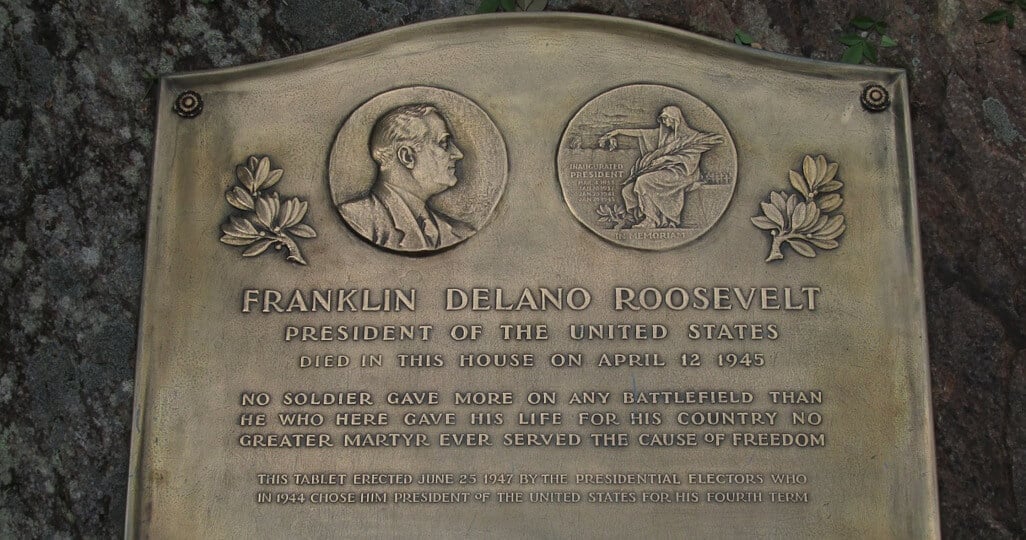
There had been concerns about his declining health during this period. The cause of death is reported as a cerebral hemorrhage. The unfinished painting from that session is on show at the Little White House in a fitting tribute to the man and the event.
Although the nation was aware of FDR’s health problems at this time, the death still came as a shock to many.
The popularity and impact of Roosevelt on the nation led to an outpouring of grief and the need for a grand ceremony at the time of his funeral.
His coffin was transported back to Washington on April 14th, where it would lie in state in the East Room of the White House. Around 500,000 people are said to have come out to watch the procession from Union Station.
There was also a large public gathering outside the White House itself. The funeral then took place in Washington, before the coffin made its way to Roosevelt’s final resting place in Hyde Park, New York.
Truman Takes Over as President To Finish the 4th Term
As Roosevelt’s vice president, it was down to Harry S. Truman to take over as president when Roosevelt died. He would complete the term and continue to see the country through to the end of the war. In a shock victory in 1948, he would earn his full term as elected president.
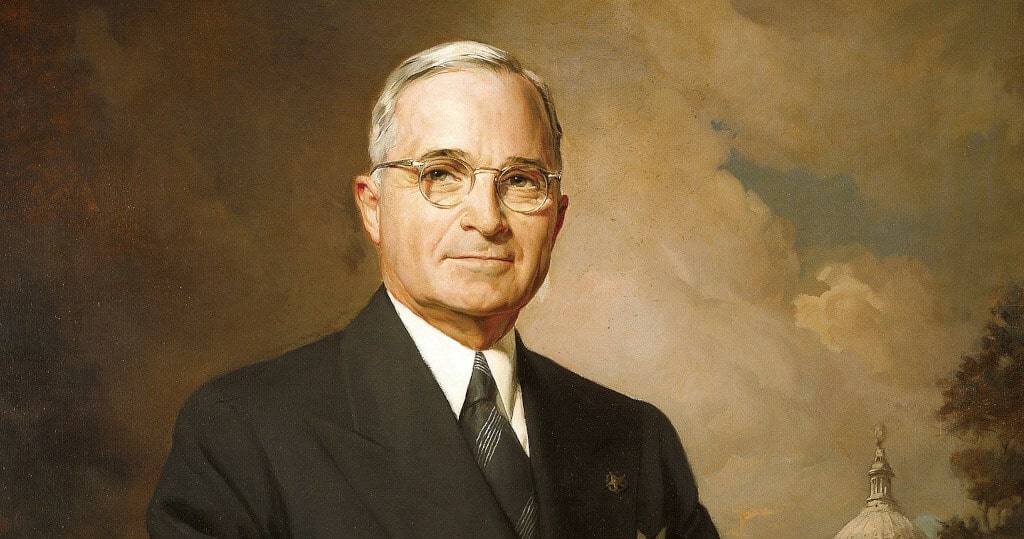
One of the Most Popular Presidents of All Time
There are always going to be experts and analysts creating lists of the best and worst presidents of all time. The rankings will always vary depending on the current political and socio-economic climates, as well as general bias. But, FDR often comes out in the top five at least.
We can criticize the length of his stay in office, although it was constitutional at the time, and there will always be debate over elements of economic and wartime policies. Still, the combination of his impact on the nation following the Great Depression and his popularity will cement his place in history.
